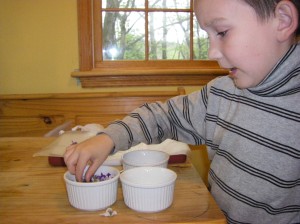I used to wonder who these people were that managed to have rhubarb at the same time as blueberries. Well, it turns out that if you don’t consume the whole rhubarb patch as Rhubarb Crunch, there will be enough for Blubarb Jam.
Okay, so it took a couple of years of plant dividing to get enough rhubarb, but –oh– I think it was well worth it.
Blubarb Jam
Ingredients:
3 cups rhubarb, finely chopped
3 cups blueberries
6 cups sugar
1/4 cup lemon juice
Procedure:
1. Chop you rhubarb very finely with a super sharp knife to eliminate that horrid, stringy rhubarb texture.
This is a good idea to keep the non rhubarb fans quiet. Generally, if guests aren’t yanking the equivalent of bitter celery strings out of their jam, they will find it delicious. It’s all about the texture with rhubarb.
2. Mash the bluberries, then measure out your 3 cups.
This is an excellent activity for a little kid. Tarp the floor. Smock the kid. Hand him a potato masher, a pie plate of blueberries and set him loose. There is no wrong way to mash them. If some of the blueberries stay whole, that’s okay too, because it adds texture to the finished product.
3. Dump all the ingredients, except the sugar in a large pot.
Make sure to use a non-reactive ( non-aluminum) pot about three times the volume of the jam. Big Pot.
4. Start by adding 4 cups of sugar.
As you heat the mixture over medium heat, stirring all the while….
When the sugar is dissolved, use a clean teaspoon to test the sweetness. I keep a huge stack of clean teaspoons by the pot, taste and pitch in the sink for cleaning so that I don’t contaminate my jam.
Be careful. The mixture can be extremely hot!
Now, is it too tart?
Add more sugar a little at a time, stirring, dissolving and clean spoon tasting as you go.
Keep track of how much sugar you add, because this is the recipe for your family and you will want to be able to reproduce the jam again without all the silly tastings.
Your next batch you will just dump the whole amount of adjusted sugar in right at the start.
5. Bring to a boil.
Be careful it doesn’t boil over. Again, big pot!
6. Reduce the heat to keep the mixture at a gentle boil.
Occasionally, pull your mixing spoon through just to be certain you ar not burning the bottom.
7. Test for sheeting.
As the mixture thickens, lift some out of the pot and let it drizzle back in. You are watching for those drips to thicken and pull toward one another.
8. Remove from heat and skim the foam.
9. Pour into sterilized canning jars and process for 20 minutes.
For more info. on the final steps or beginning canning check out these articles:
How To Make Jam — A Beginner Tutorial
How To Make Jam — The Canning Supplies
How To Make Jam — The Easy Canning Process
Strawberry-Rhubarb Jam — without added pectin
How to Raw Pack Fruit With Simple Syrup
or poke around in the cooking basics category to your right
or try the search bar.
Happy Jamming.
More blueberry recipes are on their way. Feel free to e-mail me your favorite blueberry recipe, so we can share it here.
Please let us know how your blubarb jam comes out. Questions, concerns or horrible, but delicious mishaps are always welcome.



